Coronavirus
Minnesota governor announces vaccine pilot program amid supply concerns

MINNEAPOLIS (AP) — Gov. Tim Walz announced a pilot program on Monday to vaccinate teachers, child care workers and individuals over 65 as the state aims to expand its coronavirus vaccine rollout amid concerns of a limited supply of doses from the federal government.
State officials will open nine community sites this week to vaccinate adults over 65, pre-kindergarten through 12th grade educators, school staff and child care workers. The program expands distribution efforts beyond the first high-priority group that includes healthcare workers and long-term care residents and staff, who began receiving doses last month.
“We know we have to move more quickly as a nation, we have to move more quickly as a state, we have to move more quickly as health care systems because that vaccine doesn’t do us any good if it’s not in arms,” Walz said to reporters during a Monday briefing.
Due to the small number of doses in the program’s initial inventory, the nine sites are appointment-only and won’t have the resources to immediately administer shots to all Minnesotans who are now eligible.
The announcement comes after the Democratic governor accused the Trump administration of “lying” when he and six other governors asked for permission to receive their states’ second doses from a national stockpile to ramp up their states’ vaccination efforts. The governors were told by federal officials that the administration would release the federal reserve of doses but later learned the reserve had already been exhausted.
Minnesota’s vaccine rollout has progressed slower than expected, in part due to a more limited supply of doses than anticipated. The state currently receives an allotment of 60,000 doses per week, which Health Commissioner Jan Malcolm said would take more than four months for the state to fully vaccinate the group of newly eligible recipients at that pace.
In a letter to HHS Secretary Alex Azar, Walz, Michigan Gov. Gretchen Whitmer and Wisconsin Gov. Tony Evers urged the administration to purchase more doses in the coming weeks to ramp up distribution in their states. During the briefing, Walz expressed hope for more doses from the federal government following the inauguration of President-elect Joe Biden, who pledged last week to administer 100 million doses in his first 100 days in office.
“It’s encouraging to me to see a president talking about COVID and then talking about a real plan,” he said. “My hope is that they’re low-balling and it becomes even more than (100 million) because every single one of those doses is one step closer to us getting done with this.”
As of Friday, Minnesota has administered first doses to 194,462 individuals across the state, and 38,025 have received their second dose, according to the state’s dashboard. Minnesota is on pace to administer the first of two doses to all healthcare workers and long-term care residents and staff in the first high-priority group by the end of the month.
The Minnesota Department of Health on Monday reported 980 new infections and 12 deaths, bringing the state’s totals to 447,349 cases and 5,939 deaths since the start of the pandemic.
The rate of hospitalizations continues to decline this month, though at a slower rate than last month following a peak in early December. Just over 600 patients are hospitalized for complications due to COVID-19, including 125 in intensive care.
According to The COVID Tracking Project, the seven-day rolling average of daily deaths in Minnesota continued to decrease over the past two weeks, going from more than 40 deaths per day on Jan. 3 to just over 31 deaths per day on Sunday.
Mohamed Ibrahim is a corps member for the Associated Press/Report for America Statehouse News Initiative. Report for America is a nonprofit national service program that places journalists in local newsrooms to report on undercovered issues.

